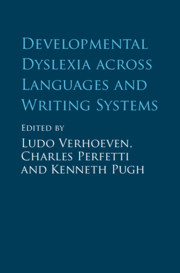Book contents
- Developmental Dyslexia across Languages and Writing Systems
- Developmental Dyslexia across Languages and Writing Systems
- Copyright page
- Contents
- Figures
- Tables
- Contributors
- 1 Introduction
- Part I Developmental Dyslexia across Languages and Writing Systems
- Part II Cross-Linguistic Perspectives on Developmental Dyslexia
- Epilogue
- Index
- References
1 - Introduction
Developmental Dyslexia – A Cross-Linguistic Perspective
Published online by Cambridge University Press: 27 September 2019
- Developmental Dyslexia across Languages and Writing Systems
- Developmental Dyslexia across Languages and Writing Systems
- Copyright page
- Contents
- Figures
- Tables
- Contributors
- 1 Introduction
- Part I Developmental Dyslexia across Languages and Writing Systems
- Part II Cross-Linguistic Perspectives on Developmental Dyslexia
- Epilogue
- Index
- References
Summary
Reading involves decoding written language in order to understand it. In learning to read, children implicitly learn how their writing system encodes their spoken language and how they can decode printed words into spoken words to derive meaning (see Verhoeven & Perfetti, 2017). However, many children around the world encounter problems learning to read, fail to develop fluent decoding, and are thus diagnosed as dyslexic.
A large body of research supports the conclusion that a phonological deficit underlies most developmental dyslexia. Much of the existing evidence, however, is based on studies of children learning to read in English. It is important to note that English has an opaque orthography that creates challenges beyond those facing children who read more transparent orthographies. In recent years, the research base for developmental dyslexia has broadened across languages, allowing the question of differences and similarities across languages and writing systems to receive attention.
- Type
- Chapter
- Information
- Publisher: Cambridge University PressPrint publication year: 2019



